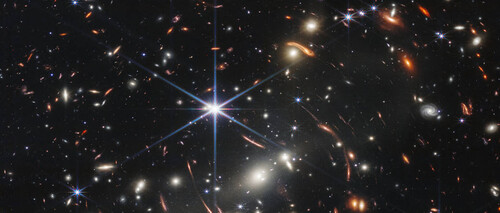As an expert, how was your experience publishing James Webb’s First Dates?
Lyudmila Caron: Most affiliates follow online publishing at home. In parallel with the press conference, we exchanged information with other experts from around the world on the Internet. Everyone saw the data for the first time and of course immediately started doing the first rough analysis in real time. JWT exceeded all expectations, recording quality is unbelievable. When we saw the first pictures, many people burst into tears of joy. It was really awesome. JWT is phenomenal and will keep us busy with discoveries for decades to come.
What separates the images shown at the press conference from the data obtained by the researchers?
Caron: All the photos presented to the public at press conferences are already underrepresentations of the data. We get unfiltered raw data. This is particularly relevant for spectral analysis: the spectrum of light that has passed through the atmosphere of exoplanet Wasp 96b is initially a speckled rainbow on a photocell. There is nothing a layman can do with it, there are spectrography experts who process this data and present it in a nice diagram, where you can see the chemical composition of the atmosphere.
raw data processing
What filtering is needed?
Caron: There are several sources of interference, such as optical artifacts due to the honeycomb shape of the JWT mirrors. This has to be taken into account to get a presentable picture. The beauty is that different groups are working independently on the same raw data at the same time. This provides us with a well-functioning quality control system.
What do you do with your research group’s data?
Caron: We take the spectrum from light that has passed through the exoplanet’s atmosphere and combine it with our models, which simulate the physics, chemistry and cloud formation. Then we see what parameters we need to change so that the model fits the observations. This could be the amount of heavy elements – in this context all except hydrogen and helium – temperature or cloud cover. Many other groups also do it back and forth internationally and interdisciplinary.
How is JWT different from predecessors like Hubble?
Unlike Hubble, which operates in the visible and UV parts of the spectrum, JWT primarily observes light in the infrared. It greatly expands our view of the universe. With Hubble, for example, no trace of clouds was observed in Wasp 96b’s atmosphere. However, the JWT has now found clues in the infrared range. Together we now get a lot of information about the universe from two telescopes.
Gem clouds on exoplanet
How can clouds be detected on exoplanets?
Caron: We’re looking at a tiny point in the distance, it’s just a pixel on the image sensor, because of course exoplanets are not resolvable from that distance. But the starlight reaching us through the planet’s atmosphere gives us information about the composition of the gases. Wasp 96b is a gas giant that orbits very close to its Sun. Even so, the planet only blocks 1 percent of the star as it passes in front of it from our point of view. And the atmosphere of this region is only one percent. Nevertheless, we can clearly see the “water hump” in the spectrum of light.
Were there any surprises in the exoplanet spectrum before JWT?
Caron: The water sign was not as strong as was commonly believed. So something weakens the signal. Depending on the data, it may only be cloudy! Namely, corundum and quartz, as these are the only materials that can still condense under the conditions of Wasp 96b. So there are practically clouds of gems out there. A 2008 paper in the journal Nature, based on Hubble observations, concluded that there were no clouds on Wasp 96b. which now needs to be amended.
What can JWT spectrometers do better than their predecessors?
Caron: Water vapor and methane are fairly transparent to ultraviolet and optical wavelengths. Infrared waves, on the other hand, are swallowed up by water vapor, methane and CO2 and then the gas appears more opaque. So we can also detect more complex molecules with infrared photons. Dust also appears in the atmosphere. JWT will teach us much about the formation of planets and galaxies and will allow us to look deeper into space and the past than ever before, and to investigate the structure of much older stars and galaxies.
Will there also be a spectral analysis of the atmospheres of Earth-like planets?
Caron: We probably won’t be able to probe the atmosphere of an Earth-like planet, but in theory, the JWT could tell whether a rocky exoplanet has an atmosphere. We now know that there are countless rocky planets. This is a huge step because until 1995 we did not confirm that exoplanets existed. Since then we have discovered many exotic types of planets not found in our solar system, such as mini Neptunes. Of course, it would also be great to see one and see an atmosphere.
Where can we look for rocky exoplanets with atmospheres?
Caron: The TRAPPIST 1 system orbits a red dwarf that regularly displays strong bursts of radiation. As a result, an atmosphere can be blown up too quickly. But if the TRAPPIST 1 system had a planet like Venus, we should be able to see the atmosphere with JWT. It is on the limit of what is possible. TRAPPIST 1 will start pouring data within the next year. If we look at an atmosphere, we have confirmed for the first time that there are rocky, gaseous planets outside our solar system.
look into the past
How far into the past can we look with JWT?
Caron: We look back about 300 million years after the Big Bang. The first galaxies were formed at that time, in which the first generation of stars was formed. These giants had only hydrogen, helium and a little bit of lithium as building materials because all the other elements were born in the first stars. For example, it took two stellar generations to manufacture iron.
As a layman, I found deep-field recording very impressive. Is it interesting even to experts?
Caron: Deepfield recording is certainly something special from a scientific point of view as well. Just a few days ago, two new galaxies were published on this basis, redshifting 12 more. This is a very deep look into the universe, two galaxies being candidates for the oldest known objects in the universe. We have never been able to see in the past so distant, this is all new territory.

Web guru. Amateur thinker. Unapologetic problem solver. Zombie expert. Hipster-friendly travel geek. Social mediaholic.





